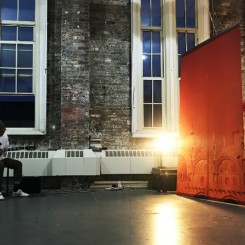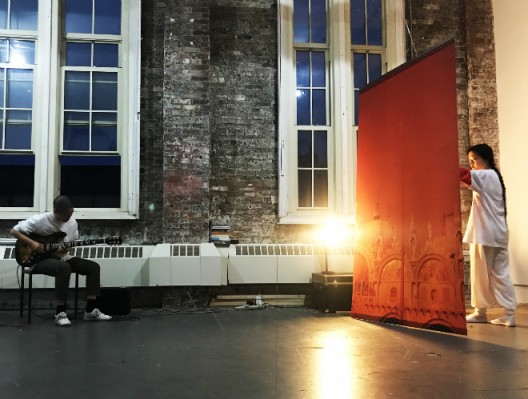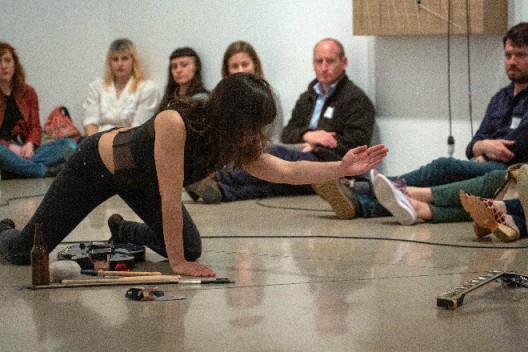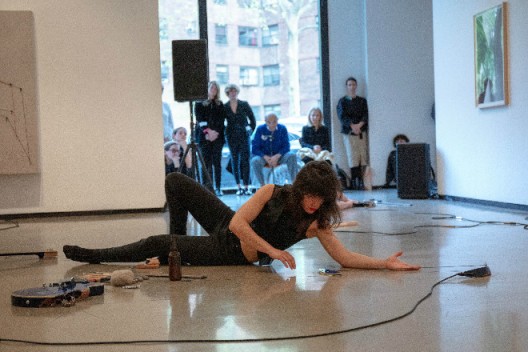By Gu Qianfan
The Third: Fairview
by Jackie Sibblies Drury, at Theatre for a New Audience
I noticed myself holding back my tears. They were falling down anyway.
Weird. The ending scene was actually too-clichéd to cry for: All white audiences were asked to get onto the stage by the leading role, a black teenage girl, Keisha. So there they were, a huge crowd of almost two hundred people, looking at us, the colored ones left in our seats, about two dozens.
If I were told about this “theatrical concept,” I would very likely boo, for its literalness and superficiality. Sitting there in the theatre, however, the intense contrast between the white majority and the colored minority was obvious and thus shocking. Plus, they were all looking at us.
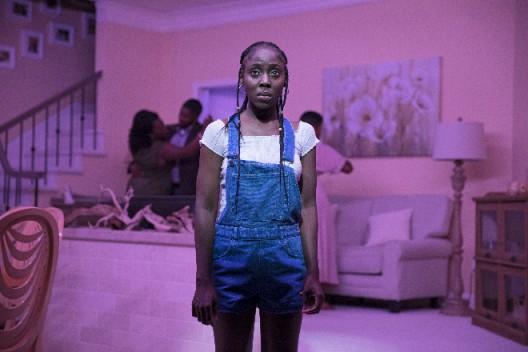
The character Keisha, in the foreground, from “Fairview,” image from the Internet. 图片来自 Soho Rep. Photo Credit: Julieta Cervantes
Keisha delivered a long speech. Her monologue started with some mumblings that kept hovering in my head: “I can’t hear anything but you staring at me. I can’t think in the face of you telling me who you think I am, with your loud self and your loud eyes and your loud guilt.”
The white crowd was literally staring at us. Their gaze was inescapable, as if they have never really looked at us, or, never truly seen the disparity before, while we, the minority, have never truly confronted it either. The direct confrontation made me uncomfortable, and maybe I cried to soothe the tension, rather than out of any grievances.
Fairview won the 2019 Pulitzer Prize in drama. Without an intermission, the play consists of three acts. A typical sitcom episode depicting family dramas opens the first third. The second is an inaudible repetition of Act One: actors go through all plots again, gesture by gesture, with voiceover from four new characters chatting about how to choose a specific race willfully — “if you could choose to be any race you want, any race at all… what race would you be?”
Act Three is very much a boisterous role-play video game. The four white commentators parachute into the family drama, playing out roles in ridiculously stereotypical ways: a glamorous-looking amiable African-American granny, a Latinex hip hop uncle, an anime style Japanese/Asian gay friend, and a dancer-like Slovenian lady with a strong accent. The whole setting of the final third and its climax farce leads Keisha to knock down the fourth wall and ask the white audience members for a real switch.
But Keisha was speaking to us, the minority — “Will they make space for us if I ask them to?” And clearly, her question can’t be answered, not by the white audiences sitting next to me who all got up on the stage later. Keisha was trying to address the issue to a larger group, the invisible ones outside theatre space.
I guess I mainly cried because, deep down, I don’t see any concrete reformative changes happening soon in real life. I hold little hope.
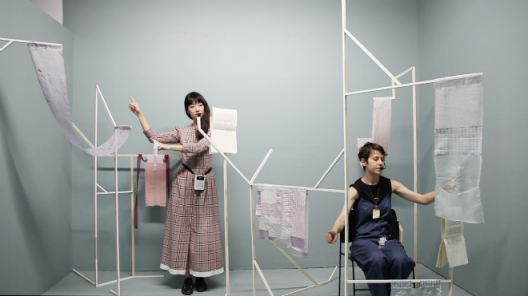
Still images from video documentation of “How slow will we appear some day? a reading of Anni Albers,” by Chang Yuchen and Jamie Boyle, Joseph Imhauser, at Lyeberry, Brooklyn. Video by Qianfan Gu. Chang Yuchen (left) and Jaime Boyle (right)
The Half: How slow will we appear someday?
by Chang Yuchen, at Lyeberry HQ
I was invited by artist Chang Yuchen to be the one and only audience for her performance (and be the camerawoman to record it). Because her collaborator Jaime Boyle could handle only one audience, not even two.
Yuchen and Jaime had a residency at the Textile Center in Brooklyn last year. They both just finished being studio artists at the Museum of Arts and Design recently. Their performance happened at Joseph Imhauser’s alternative space Lyeberry HQ. In the end of it, Joseph also played a part: holding a hot glue gun in hand, he walked by slowly and then stood with his back to me, fixing details of the installation.
The exhibition space of Lyeberry feels like a suitcase. It’s a 12-foot cube within a studio separated by a thin wall through which you might spot Joseph playing on an old-fashioned piano. Lyeberry has this mysterious light blue color — “it’s the mixture of all sorts of leftover paints,” Joseph explained: “a color of all colors.”
I felt like being inside one of Zoe Leonard’s suitcases from her ongoing piece 1961.
The installation on view is constituted of wooden battens and patched fabrics. The fabrics are Yuchen’s work; she collected small pieces of cloth from men’s shirts and sewed them together. She wore a long dress with similar patterns. Plaid can have lots of variations, but there is no substantial content within such richness. I think of men sitting behind computers in offices wearing all sorts of plaid shirts. Their suits, tasks, and schedules all share a strong sense of homogeneity.
The main thing of the performance is reading excerpts from Anni Albers’ On Weaving (1974). Albers went to the Black Mountain in the 1930s, coming from the Bauhaus in Germany. She was deeply influenced by the pre-Columbian art and textile craft that she had encountered on numerous trips to Mexico. Albers incorporated these learned weaving techniques into art practice. In her writing both Albers’ neat language and divergent thinking speak loudly about weaving as something that, “has remained essentially unchanged to this day” since its invention. The basic mechanism of weaving – including the two core components, warp and weft, the stretching force needed in the process of interlocking threads, and the shuttle loom as “a minimum of equipment” – makes the activity a prototype.
One standing, the other sitting, Yuchen and Jaime, wearing portable speakers and microphones, performed the reading with the installation surrounding them. Their tones went gently along with gestures emphasizing specific verbs.
For the two artists, who use a lot of textile elements in their art, reading Albers had a sense of introspection.
Yuchen further explained the connection between weaving and the computer programs’ binary system to me. It made perfect sense why she highlighted plaid shirts in the work. There’s truly a sense of similarity. Perhaps, the textures of our social organizations have always been as regular, mediocre, and endlessly repetitive as men sitting behind computers. It’s just now we are so in the belief of “individualism,” while the truth might be that we are just like those plaid shirts, the most forgettable ones, the ones in disguise of seemingly special but boring patterns.
The Second: Drips
by Yan Yitian, at 107 Suffolk Street
“1110,” the title of artist Yan Yitian’s solo exhibition seems to imply the binary system of our digital era; whereas in fact, it is evolved from the pictographic “|||○” — referring to the recurrent lines and circles in her work. Lines and circles are usually two-dimensional visual components, but they become constructive elements in Yan’s three-dimensional installation, they are movable, and capable of making sounds.
The exhibition 1110 was held in a Dutch Neo-Gothic building in New York, which used to be a public school, and became an art project, including artists’ studios, theatres, galleries, and rehearsal spaces, after renovation in the 1990s. Many of Yan’s installation parts attempted to initiate a direct dialogue with this old building, such as the huge vertical-hanging red photo in the center of the gallery space, showing an image of a church square from some European cities — as if taking the exterior of the building into its interior. Moreover, the column shown in the picture echoed with the column standing inside the Dutch building.
The large red photo was pulled by a diagonal fish line to the weight on the ground. The thin and transparent line made itself almost invisible and the device of the photo almost without supporting.
Column vs. the seemingly unsupported photo, the two devices form a pair of intertextual imageries. The tall and thin column, the tall and thin photo. Both are a declaration about a sense of verticality. Their straight and tall and thin lines reminded me of human beings’ upright walking. They’re robust, steep, trying to get rid of gravity, yet still firmly rooted in the ground.
At the opening, Yan collaborated with artist Casper Wang for a performance piece titled Drips. Wang was the electric guitarist; while Yan turned all the lines into strings, she operated the entire space to resonate a choir: the fishing lines of the photo, the curved metal piece suspending like a swing, the structure looking like a miniature signal tower, and the cone-shaped snow gauge (雪晷) with ice in it. Movements caused tremors and in turn made a sound of objects. Same as the electric guitar, it is in essence a three-steps-in-one-instrument: vibration – sounding – amplification of the sounding. Yan used amplifying equipment quite a lot, she maximized the sound from the strings. Therefore, the rotation of the photo, the distortion of the metal piece, the slight trembling from the signal tower, the dripping from the melting ice, together with the guitar, and the tiniest movements from the audiences, all became sound sources. They sang out loud in the same space.
Yan’s adaption of a snow gauge was especially unique; for first and foremost, its cone shape being a simple combination of two straight lines and a circle. A cone makes me think of a loudspeaker, and when vertically inverted, it becomes a container, an ice-cream cone, and here, a cup of melting ice. The artist mentioned to me about Dream of the Red Chamber from Ming Dynasty, people used jars, cans, and all kinds of containers to collect rain, snow, and dew under particular weather and geographical conditions to brew tea and/or irrigate crops. The nature, the geography, the climate, the temporal and the spacial, can all be reflected in the storage and usage of water. A snow gauge is a symbol of the shifting status of water from solid to fluid. It is a condensed form containing a ritual of life maintenance.
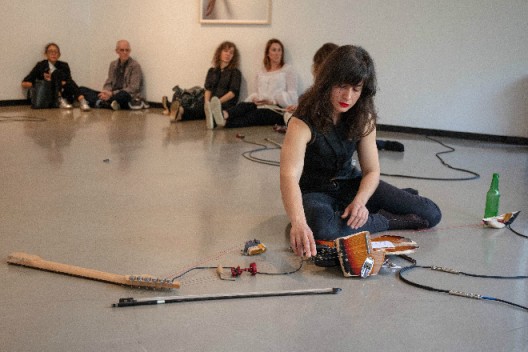
艺术家Naama Tsabar在卡斯明个展“Dedicated”的现场图,2019年3月13日—5月4日。摄影/ Christopher Stach 图片致谢卡斯明画廊
Installation view of Naama Tsabar Dedicated at Kasmin Gallery. March 13 – May 4, 2019. Photography by Christopher Stach. image courtesy of Paul Kasmin Gallery.
The First: Melodies of Certain Damage
by Naama Tsabar, at Paul Kasmin
What happens after a guitarist slammed his instrument on stage? Usually, a crushed guitar would end a concert in its climax. But for artist Naama Tsabar, the macho and violent gestures are embedded with gendered implications and thus questionable.
In 2010, Tsabar, who used to be in a punk band, acted out a similar scene during her performance Untitled (Babies) at Art Basel Miami, for a group show curated by Rirkrit Tiravanija. The piece featured a band of four women musicians performing. In the center of the stage, Tsabar, as the leading vocalist, sang out the Pulp’s classic song “Babies.” She then took her guitar off and pounded it against the floor, while the band members continued playing in the background. Tsabar kept striking, hitting, banging, until the stage’s wooden floor cracked into pieces, and until she herself exhausted and finally stopped, whereas the guitar — being cast from some certain durable material — remained safe and sound.
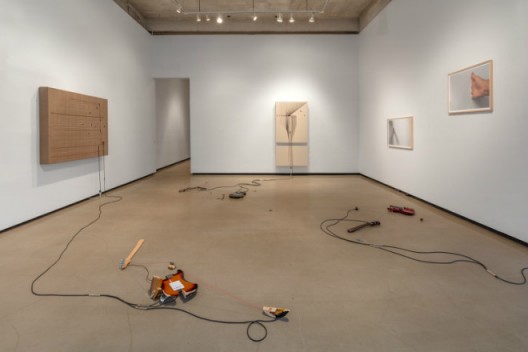
艺术家Naama Tsabar在卡斯明个展“Dedicated”的现场图,2019年3月13日—5月4日。摄影/ Christopher Stach 图片致谢卡斯明画廊
Installation view of Naama Tsabar Dedicated at Kasmin Gallery. March 13 – May 4, 2019. Photography by Christopher Stach. image courtesy of Paul Kasmin Gallery.
The generic guitar shape is based on a woman’s body. Unlike most male guitarists, a guitar is a profound symbol and definitely not vulnerable for Tsabar. It could turn out to be a formidable weapon to shake off an entire stage.
In her series Melodies of Certain Damage (2018), shown at Paul Kasmin Gallery this spring, Tsabar tried out a different approach: she carefully positioned fragments of smashed guitars, set new strings on them, connected them to the minimalist-painting-looking amplifiers on the wall – her Transitions (2018) series, and revived the broken parts to be functional and sonic again.
Tsabar’s feminism stance is praiseworthy, for she not only raises questions, but also presents a proposal. In the closing performance of her show, the artists appeared with several female musicians. They used a variety of tools, like glass bottles and all sorts of plectrums, to perform with the broken guitar pieces. Their melodies were not as soft and sweet as feminine, but firm and tenacious. Especially the drumming part of the performance, during which a musician lifted her hands with drumsticks and used the ground as drumhead to make out a dull but powerful rhythm.
I’m touched by the performers’ body poses. Since the debris are scattered on the ground, the music instrument now becomes something not handy at all. One can no longer carry or hold or lift her guitar, but adjust to kneeling or squatting to fit the broken guitar parts. The objects get to shape their players, not vice versa.
If the guitarist and his instrument form a metaphor for the traditional male-female relationship, Tsabar asked everyone to be more flexible, she proposed the possibility of improvement by readjusting our positions and fixing the broken parts.
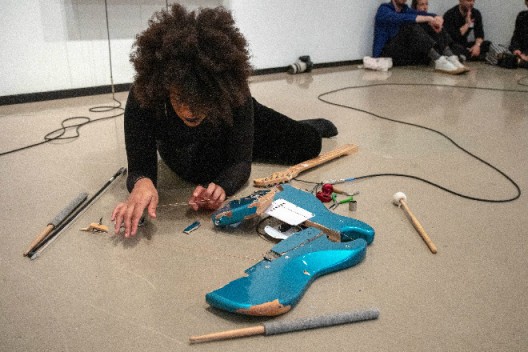
艺术家Naama Tsabar在卡斯明个展“Dedicated”的现场图,2019年3月13日—5月4日。摄影/ Christopher Stach 图片致谢卡斯明画廊
Installation view of Naama Tsabar Dedicated at Kasmin Gallery. March 13 – May 4, 2019. Photography by Christopher Stach. image courtesy of Paul Kasmin Gallery.
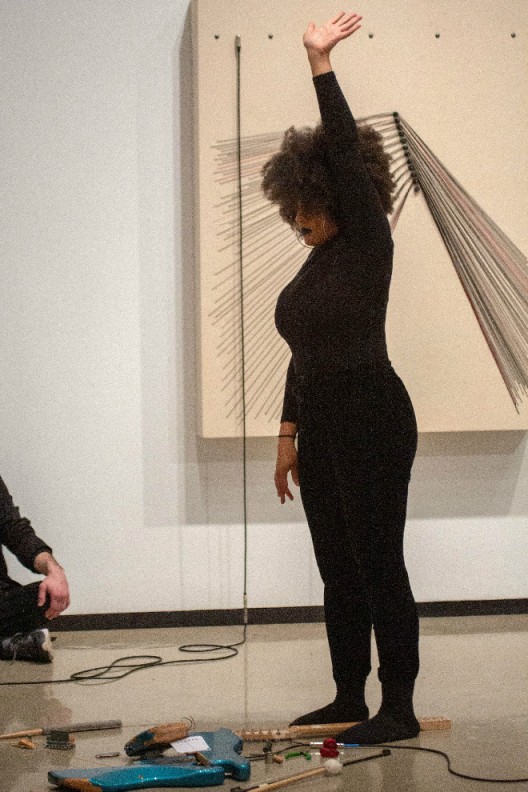
艺术家Naama Tsabar在卡斯明个展“Dedicated”的现场图,2019年3月13日—5月4日。摄影/ Christopher Stach 图片致谢卡斯明画廊
Installation view of Naama Tsabar Dedicated at Kasmin Gallery. March 13 – May 4, 2019. Photography by Christopher Stach. image courtesy of Paul Kasmin Gallery.
